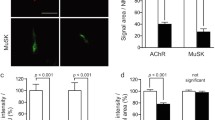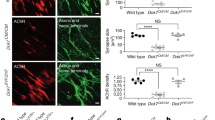Abstract
Acetylcholinesterase (AChE) at the neuromuscular junction (NMJ) is anchored to the synaptic basal lamina via a triple helical collagen Q (ColQ) in the form of asymmetric AChE (AChE/ColQ). We exploited the proprietary NMJ-targeting signals of ColQ to treat congenital myasthenia and to explore the mechanisms of autoimmune myasthenia gravis (MG). Mutations in COLQ cause congenital endplate AChE deficiency (CEAD). First, a single intravenous administration of adeno-associated virus serotype 8 (AAV8)-COLQ to Colq−/− mice normalized motor functions, synaptic transmission, and partly the NMJ ultrastructure. Additionally, injection of purified recombinant AChE/ColQ protein complex into gluteus maximus accumulated AChE in non-injected forelimbs. Second, MuSK antibody-positive MG accounts for 5–15 % of MG. In vitro overlay of AChE/ColQ to muscle sections of Colq−/− mice, as well as in vitro plate-binding of MuSK to ColQ, revealed that MuSK-IgG blocks binding of ColQ to MuSK in a dose-dependent manner. Passive transfer of MuSK-IgG to wild-type mice markedly reduced the size and intensity of ColQ signals at NMJs. MuSK-IgG thus interferes with binding of ColQ to MuSK. Elucidation of molecular mechanisms of specific binding of ColQ to NMJ enabled us to ameliorate devastating myasthenic symptoms of Colq−/− mice and also to reveal underlying mechanisms of anti-MuSK-MG.


Similar content being viewed by others
References
Cartaud A, Strochlic L, Guerra M et al (2004) MuSK is required for anchoring acetylcholinesterase at the neuromuscular junction. J Cell Biol 165:505–515
Deprez P, Inestrosa NC, Krejci E (2003) Two different heparin-binding domains in the triple-helical domain of ColQ, the collagen tail subunit of synaptic acetylcholinesterase. J Biol Chem 278:23233–23242
Farrugia ME, Vincent A (2010) Autoimmune mediated neuromuscular junction defects. Curr Opin Neurol 23:489–495
Farrugia ME, Robson MD, Clover L et al (2006) MRI and clinical studies of facial and bulbar muscle involvement in MuSK antibody-associated myasthenia gravis. Brain 129:1481–1492
Higuchi O, Hamuro J, Motomura M, Yamanashi Y (2011) Autoantibodies to low-density lipoprotein receptor-related protein 4 in myasthenia gravis. Ann Neurol 69:418–422
Ito M, Suzuki Y, Okada T et al (2012) Protein-anchoring strategy for delivering acetylcholinesterase to the neuromuscular junction. Mol Ther 20:1384–1392
Kawakami Y, Ito M, Hirayama M et al (2011) Anti-MuSK autoantibodies block binding of collagen Q to MuSK. Neurology 77:1819–1826
Kim N, Stiegler AL, Cameron TO et al (2008) Lrp4 is a receptor for agrin and forms a complex with MuSK. Cell 135:334–342
Kimbell LM, Ohno K, Engel AG, Rotundo RL (2004) C-terminal and heparin-binding domains of collagenic tail subunit are both essential for anchoring acetylcholinesterase at the synapse. J Biol Chem 279:10997–11005
McConville J, Farrugia ME, Beeson D et al (2004) Detection and characterization of MuSK antibodies in seronegative myasthenia gravis. Ann Neurol 55:580–584
Mihaylova V, Muller JS, Vilchez JJ et al (2008) Clinical and molecular genetic findings in COLQ-mutant congenital myasthenic syndromes. Brain 131:747–759
Ohno K, Brengman J, Tsujino A, Engel AG (1998) Human endplate acetylcholinesterase deficiency caused by mutations in the collagen-like tail subunit (ColQ) of the asymmetric enzyme. Proc Natl Acad Sci U S A 95:9654–9659
Pasnoor M, Wolfe GI, Nations S et al (2010) Clinical findings in MuSK-antibody positive myasthenia gravis: a U.S. experience. Muscle Nerve 41:370–374
Sigoillot SM, Bourgeois F, Lambergeon M, Strochlic L, Legay C (2010) ColQ controls postsynaptic differentiation at the neuromuscular junction. J Neurosci 30:13–23
Zhang B, Luo S, Wang Q, Suzuki T, Xiong WC, Mei L (2008) LRP4 serves as a coreceptor of agrin. Neuron 60:285–297
Acknowledgments
The current studies were supported by grants-in-aid from MEXT and NHLW of Japan.
Author information
Authors and Affiliations
Corresponding author
Rights and permissions
About this article
Cite this article
Ohno, K., Ito, M., Kawakami, Y. et al. Collagen Q is a Key Player for Developing Rational Therapy for Congenital Myasthenia and for Dissecting the Mechanisms of Anti-MuSK Myasthenia Gravis. J Mol Neurosci 53, 359–361 (2014). https://doi.org/10.1007/s12031-013-0170-x
Received:
Accepted:
Published:
Issue Date:
DOI: https://doi.org/10.1007/s12031-013-0170-x




